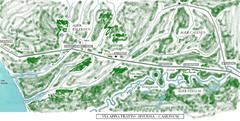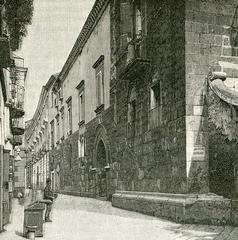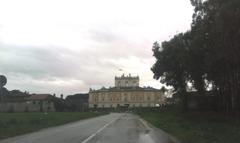Sant’Angelo in Formis, Capua, Italy: Visiting Hours, Tickets, and Historical Guide
Date: 15/06/2025
Introduction
Perched on the slopes of Monte Tifata near Capua in Italy’s Campania region, Sant’Angelo in Formis is a captivating medieval basilica. Celebrated for its remarkable blend of history, art, and architecture, the basilica stands as a testament to the layered religious and cultural evolution of southern Italy. From its origins as a Roman temple dedicated to Diana Tifatina, it was transformed into a Christian sanctuary devoted to St. Michael the Archangel. The church, rebuilt between 1072 and 1087 under Abbot Desiderius of Montecassino, showcases the Benedictine order’s commitment to spiritual and artistic renewal during the Middle Ages (Comune di Capua; Ministero della Cultura).
Sant’Angelo in Formis is renowned for its masterful architectural fusion of Romanesque and Byzantine styles, the reuse of ancient Roman columns, and its extraordinary fresco cycle—one of the most complete in Western Europe. This comprehensive guide details the basilica’s history, architectural highlights, artistic treasures, practical visitor information, travel tips, and nearby attractions to help you make the most of your visit.
Origins and Early History
The site of Sant’Angelo in Formis has been sacred for centuries. Originally home to a temple dedicated to Diana Tifatina, it occupied a strategic position overlooking the ancient Via Appia and the Volturno valley (Comune di Capua). As Christianity spread, the pagan temple was supplanted by a sanctuary dedicated to St. Michael the Archangel—a figure especially venerated by the Lombards. Archaeological and documentary evidence points to a Christian presence as early as the 9th century, with further activity suggested by earlier remains.
Architectural Significance
The basilica as seen today was constructed between 1072 and 1087, commissioned by Abbot Desiderius of Montecassino (Ministero della Cultura). The structure is a masterwork of Romanesque design, featuring three naves separated by ancient Roman columns (spolia), a raised presbytery, and a semicircular apse. The reuse of classical materials symbolizes the transition from pagan to Christian worship, and the basilica’s architecture reflects the cultural crossroads of southern Italy, blending Western and Eastern influences.
The exterior is distinguished by solid masonry, a 13th-century portico with Gothic arches, and a sculpted lunette above the entrance depicting the Madonna Orans flanked by angels. Inside, visitors are greeted by light streaming through clerestory windows and a harmonious arrangement of columns and arches.
The Frescoes: A Medieval Artistic Treasure
Sant’Angelo in Formis is famous for its extensive and well-preserved fresco cycle, painted by artists of both Byzantine and Campanian traditions between the late 11th and early 12th centuries (Italia Nostra). The frescoes cover the nave, aisles, and apse, depicting scenes from the Old and New Testaments, saints’ lives, and the Last Judgment. The cycle is notable for its blend of Byzantine solemnity and Latin narrative expressiveness, functioning as a visual “Bible of the poor” for the medieval faithful.
Key highlights include:
- The Christ Pantocrator in the apse, surrounded by saints and angels.
- Old Testament scenes along the aisles.
- Narratives from the life of Christ in the nave.
- A dramatic Last Judgment on the counterfaçade.
The frescoes’ vibrant colors and expressive figures have been remarkably well preserved, offering visitors an immersive experience of medieval art (italia.it).
Cultural and Historical Importance
The basilica’s dedication to St. Michael the Archangel underscores the Lombard and Norman influence in the region, while its association with Monte Cassino places it at the heart of medieval monastic reform and artistic patronage (Abbazia di Montecassino). Despite suffering damage during events like the 1266 sack of Capua, Sant’Angelo in Formis remained a significant pilgrimage and cultural site, reflecting the resilience and continuity of local identity (Enciclopedia Treccani).
Architectural Structure and Evolution
Site Origins and Layers
Beneath the basilica lie the remains of the ancient temple of Diana, whose presence is visible in reused columns and foundations (reggiadicaserta.cultura.gov.it). The coexistence of pagan and Christian layers is a powerful symbol of religious transformation in the region.
Romanesque Basilica: Plan and Decorative Elements
The church’s plan features a central nave with two aisles, divided by fourteen columns, many spolia from the earlier temple. The high nave is illuminated by clerestory windows, and the semicircular apse provides a focal point for the majestic Christ Pantocrator fresco. The 13th-century portico at the entrance, with its Gothic arches and sculpted lunette, reflects later modifications while harmonizing with the ancient structure.
Sculptural Program
Above the main entrance, an inscription honors Abbot Desiderius. The lunette’s Madonna Orans, flanked by angels, and ogival arches on the portico sides featuring scenes of hermits Anthony the Abbot and Paul of Thebes, introduce the rich iconographic program found within.
The Fresco Cycle: Artistic and Iconographic Significance
The basilica’s 96 frescoes, completed between 1072 and 1087, were created by artists blending local and Byzantine styles. The iconographic program narrates the drama of salvation:
- Old Testament scenes in the aisles.
- Life of Christ in the nave.
- Apse featuring Christ Pantocrator and the celestial court.
- Counterfaçade with the Last Judgment.
Unique local themes include the martyrdom of Saint Pantaleon and the Cumaean Sibyl, while portraits of Abbot Desiderius and scenes of hermit life reflect Benedictine ideals. The stylistic synthesis of Western Romanesque clarity and Byzantine gold backgrounds underscores Montecassino’s cultural ties to the Eastern Mediterranean.
Artistic and Cultural Context
Sant’Angelo in Formis was integral to the monastic reforms of Montecassino, supported by Lombard and Norman rulers. The frescoes, serving both didactic and spiritual purposes, reinforced Montecassino’s authority and the Benedictine vision of monasticism as a center of learning, prayer, and art (wikipedia.org). The integration of ancient and Christian elements is echoed in both structure and decoration, symbolizing the Christianization of a pagan site and the layering of religious traditions.
Despite later repairs and modifications, the basilica retains much of its original form and remains a powerful testament to medieval spirituality.
Visiting Sant’Angelo in Formis: Hours, Tickets, and Tips
Opening Hours
- General: Tuesday through Sunday, 9:00 AM – 6:00 PM. Closed on Mondays and major holidays.
- Occasional Variations: During special events, hours may extend or change—check the official website for updates.
Tickets and Admission
- Standard Admission: €5 for adults.
- Discounts: Reduced rates for students and seniors; children under 12 enter free.
- Donation: Occasionally, a nominal fee (e.g., €1) may be requested for preservation (History Hit).
- Guided Tours: Available daily or by appointment; booking in advance is recommended (Touring Club Italiano).
Accessibility
The basilica is partially accessible to visitors with limited mobility. Some areas may pose challenges due to uneven surfaces, but assistance is available by request.
Getting There
- By Car: From Caserta, follow SS 700 towards Capua, then follow signs to Sant’Angelo in Formis. Parking is available near the basilica (History Hit).
- By Public Transport: Take a regional train from Caserta to Santa Maria Capua Vetere, then bus line 7 to Piedimonte Matese. The basilica is a 15-minute walk from the bus stop.
Visitor Tips
- Dress Code: Modest attire is respectful, as the church remains an active place of worship.
- Photography: Non-flash photography is permitted; always check posted guidelines.
- Amenities: Restrooms and a small gift shop are onsite. Cafés and shops are nearby in the village.
- Best Time to Visit: Weekday mornings are less crowded; consider timing your visit during local festivals for a richer experience.
Events and Nearby Attractions
Sant’Angelo in Formis is a living spiritual center, hosting religious festivals (especially for St. Michael on September 29th), concerts, and cultural events. The basilica has also been recognized for its ecumenical significance, as demonstrated by recent visits from the Ecumenical Patriarch of Constantinople (Dea Notizie).
Nearby Attractions:
- Arco di Diana: Remains of the ancient temple, including ritual basins and walls.
- Monte Tifata: Hiking trails with panoramic views over the Volturno valley.
- Capua: Roman amphitheater, ancient city walls, and the Arch of Hadrian.
- Caserta: The Royal Palace of Caserta is a short drive away.
Cultural Activities: The village hosts events such as the Sentiero del Re, a historic hunting trail established by King Ferdinand IV (Touring Club Italiano).
Frequently Asked Questions (FAQ)
Q: What are the opening hours?
A: Tuesday to Sunday, 9:00 AM – 6:00 PM; closed Mondays.
Q: How much is admission?
A: €5 for adults, discounts for students/seniors, children under 12 free. Occasionally, a €1 donation is requested.
Q: Are guided tours available?
A: Yes, daily or by appointment; recommended for deeper insight.
Q: Is the basilica wheelchair accessible?
A: Partially accessible; some uneven surfaces exist, but assistance is available.
Q: Can I take photos inside?
A: Non-flash photography is allowed in most areas.
Q: How do I get there from Caserta?
A: By car via SS 700 or by regional train and bus, followed by a short uphill walk.
Q: What else can I visit nearby?
A: Capua’s ancient ruins, the Royal Palace of Caserta, Monte Tifata trails, and more.
Plan Your Visit and Explore More
Sant’Angelo in Formis is a must-see for enthusiasts of medieval art, Romanesque architecture, and the intertwined history of pagan and Christian traditions in southern Italy. With its breathtaking frescoes and serene setting, the basilica offers a deeply immersive cultural and spiritual experience. For the latest updates, guided tour options, and local events, download the Audiala app and follow us on social media.
Summary of Key Points and Visitor Recommendations
Sant’Angelo in Formis is a historical and cultural treasure, uniquely embodying the intersection of ancient Roman, Lombard, and Benedictine traditions. Its architectural grandeur, exceptional fresco cycle, and ongoing role as a place of worship make it a highlight of Campania’s heritage. Plan your visit by checking current hours and ticket information, arranging a guided tour if possible, and exploring nearby attractions to enrich your experience (basilicainformis.altervista.org; historytools.org).
Sources and Further Information
- Comune di Capua
- Ministero della Cultura
- Italia Nostra
- Abbazia di Montecassino
- Enciclopedia Treccani
- History Hit
- Touring Club Italiano
- Regia di Caserta Cultura
- Dea Notizie
- Basilicainformis.altervista.org
- Italia.it
- Mondo Vagando Senza Meta
- History Tools


